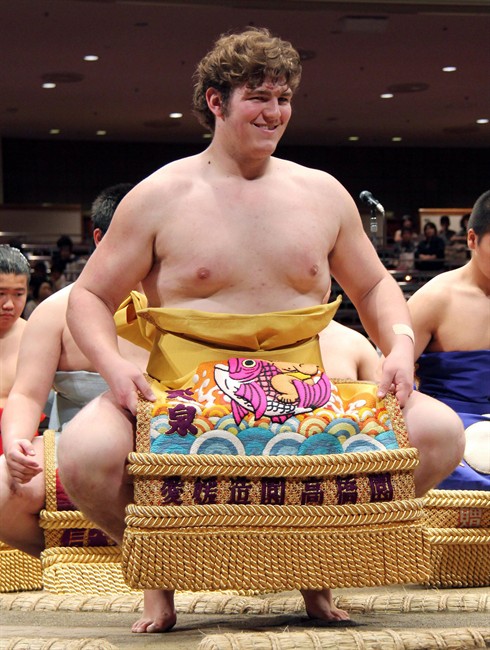TOKYO – Canadian Brodik Henderson is hoping his prowess in the remote world of U.S. amateur sumo wrestling will translate into a professional career in the heartland of Japan’s ancient sport.

The 20-year-old native of Victoria, British Columbia, who stands 6-foot-7 and weighs 360 pounds, will make his debut at the Nagoya Grand Sumo Tournament which begins on Sunday.
Henderson, whose ring name is Homarenishiki, won the men’s openweight title at the U.S. Sumo Open last year. But winning in U.S. amateur sumo and succeeding in a sport steeped in ancient rituals and Japanese tradition are two completely different things.
READ MORE: Heavyweight performance: Canadian Opera Company recruits sumo wrestlers for show
There are no fist bumps, high-fives or body slams in Japanese sumo. Wrestlers humbly bow to their opponents and are expected to uphold the rigid customs of the ages-old sport. Life outside the ring is just as demanding.
“Brodi is level-headed, diligent and friendly which serves him well in Japan,” said John Gunning, a sumo analyst who has followed the sport for about 14 years. “He has the ability to see the bigger picture which is rare in young athletes so I think he will be fine. He knows his own weaknesses and is working hard to overcome them.”
Sumo wrestlers, known as “rikishi” live in communal training stables where all aspects of their daily lives from meals to what they wear are dictated by strict traditions. Like all the younger wrestlers in the lower ranks, Henderson will be required to perform a variety of menial tasks that include cleaning toilets and washing the clothes of senior wrestlers.

Get breaking National news
That may not be easy for someone who grew up playing American football, ice hockey and was active on social media up until now.
Because Henderson enters the sport at the lowest division of jonokuchi, the Internet is a no-no for now. Many foreigners over the years have had trouble grappling with sumo’s unique customs.
“It’s not for everyone,” said Gunning. “The road to the top and lifestyle are much harder than people imagine. Usually, it’s the stuff outside the ring and how well foreign rikishi deal with it that determines their fate.”
Many sumo purists say foreign wrestlers lack the culture and manners – often described as “hinkaku”, or dignity – to reach the higher ranks.
Mongolian Asashoryu reached the highest rank of yokozuna. But his boisterous behaviour outside the ring derailed his career. He was eventually forced out of sumo after being involved in several incidents, including in a late-night brawl in Tokyo’s Roppongi district.
Hawaiian Akebono also reached the highest rank of yokozuna and was able to adjust to life in Japan. Gunning says Akebono serves as a good role model for Henderson.
“If he can develop a style similar to former yokozuna Akebono I think his chances of a long and healthy career increase exponentially,” Gunning said.
As the only North American in sumo, the spotlight will be on Henderson, who isn’t the first Canadian to try his hand at sumo.
In 1985, John Tenta, also a native of British Columbia, fought under the ring name Kototenzan. He got off to stellar 21-0 start but had trouble adapting to life in Japan and retired in 1986.
His abrupt departure did not go over well with sumo’s hierarchy.
Henry Armstrong Miller, the son of an African-American father and Japanese mother, fared better than Tenta. He reached the second-highest juryo division in a career that went from 1988 to 2003.
Miller, who grew up in St. Louis, fought under the ring name Sentoryu, and compiled a career record of 403 wins, 303 losses and 99 defaults.
He notched some impressive wins over some of the sport’s biggest names in his long career but was forced to retire in 2003 after a series of injuries.
History has proven that brute force does not always guarantee success in sumo, a sport which has over 82 winning techniques known as “kimarite.” There have been many smaller wrestlers over the years to rise up the ranks.
Sumo is now dominated by Mongolians who have a much easier time adapting, having grown up with the country’s traditional form of wrestling or “bokh” which is a revered national sport.
Still, Henderson has displayed the right attitude so far, doing everything he can to learn the customs and fit in. No small task for a 6-foot-7 Canadian in Japan.







Comments